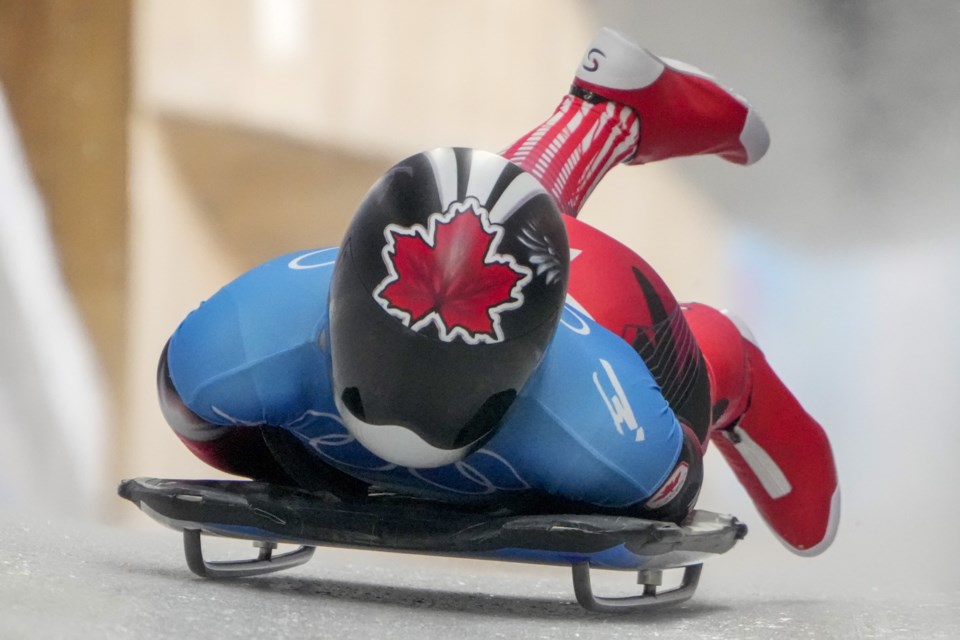After a disappointing result on the World Cup circuit, Canadian slider Jane Channell knew she needed something to motivate herself beyond getting better results on the skeleton track.
To create a tangible goal for herself, she commissioned a brand new helmet that she would only wear at the Beijing Olympics. That is, if she made sa���ʴ�ý's Olympic team.
"It was my worst result in a World Cup ever and so just being able to have that to hold on to was massive motivation," said Channell after she finished 24th at Altenberg, Germany. "Just, it's going to be OK, keep going, keep pushing. Keep your chin up. It really, really did help."
Regardless of how Channell did at the Winter Games, she considered the helmet her prize. She wore it throughout training and competition at Yanqing National Sliding Centre, where she placed 17th.
"It was almost like I get to wear my little personal trophy," said Channell, who is from North Vancouver, sa���ʴ�ý "This season cost me a lot money because we were all self-funded.
"Everything from coaching to rental cars to flights, accommodation, everything, food, everything, was on each of us to pay. So this was my Christmas gift to myself, my good-job, you-made-it gift."
Channell chose the design elements herself.
Heavily influenced by mythology, the helmet has a Japanese dragon on its right cheek and a Phoenix on its left. The top of the helmet has a Maple Leaf — for obvious reasons, laughs Channell — from the leaf are two rays with the years 2018 and 2022 in them to represent the two Olympics she has competed in.
The helmet also has some paw prints for Channell's cat as well as a broom, commemorating when she was hit by the cleaning tool during a skeleton World Cup event in Igls, Austria, in 2015. On the nose of her helmet she has wings with a No. 7 to memorialize her boyfriend Bernd Dittrich, who died in 2009. Dittrich wore No. 7 as quarterback of Simon Fraser University's football team.
Channell said a lot of her international competition took note of the helmet at the Beijing Olympics.
"Because the tone here is always quite serious being at the Games and everything I get a lot of like pointing and head nods and thumbs up signs for it," said Channell. "So it's a silent approval."
One person who was vocal in his approval of her helmet was Canadian teammate Blake Enzie. Channell introduced Enzie to Ian Johnson, the Vancouver-based artist that did her helmet.
"I didn't want to go to the Olympics with a blank canvas," said Enzie, who has been wearing his helmet for the entire World Cup season. "I figured if I did have the chance to represent sa���ʴ�ý, then I'd be able to put my family and my roots on display.
"I mean, the Olympics are the biggest stage in the world, so might as well."
Enzie, who is from Calgary, has a prairie motif on his helmet.
Wheat flowers adorn the sides of it, airbrushed to look like they're blowing with the wind as Enzie slides down the track. The wheat field wraps around the back and sides of the helmet, while the blue top represents the Albertan sky with Maple Leafs around the front.
Each side has sa���ʴ�ý written in a wild rose pink, and on the back of the helmet he has the birthdays of his grandparents, parents, and sister.
"When you pay tribute to family and your heritage, you can't really get sick of the design," said Enzie, who was 20th in skeleton at the Beijing Olympics. "So once (Johnson) came up with design I was like, 'yeah, it's a done deal. Let's let's put in a wheat field.'
"Since my family does have a grain farm, it represents my heritage well."
This report by The Canadian Press was first published Feb. 16, 2022.
John Chidley-Hill, The Canadian Press

